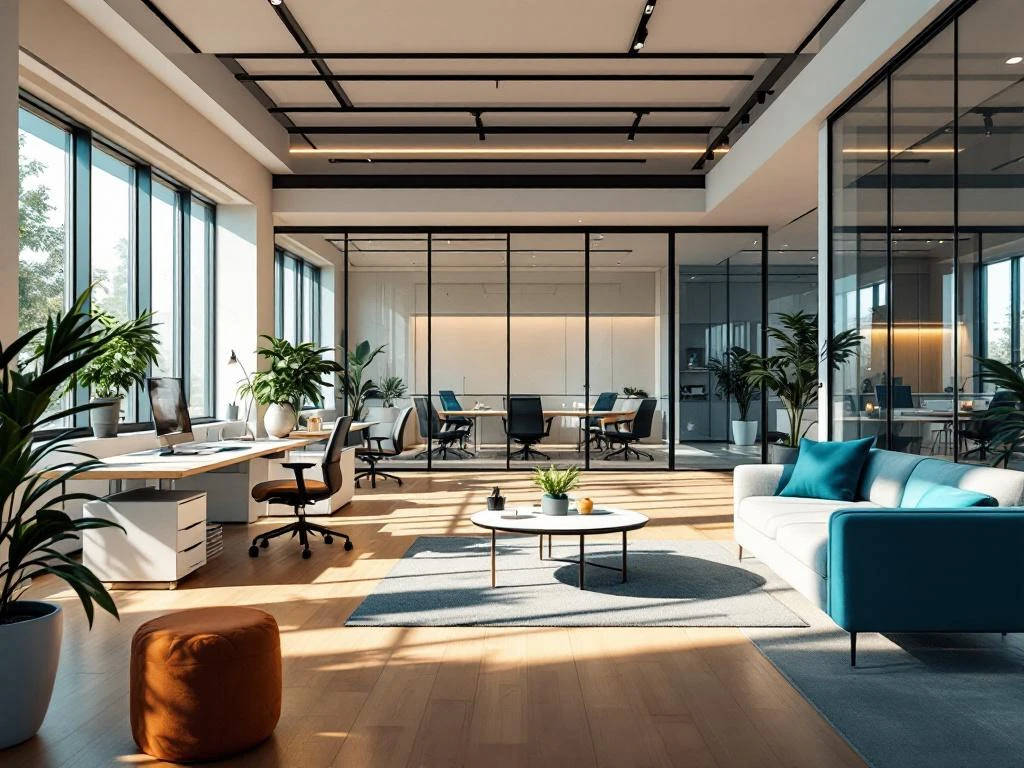Office space includes all spaces used primarily for administrative work, business services and intellectual labor. According to the Building Code and real estate terminology, these are spaces where desk work, meetings and business activities take place. These can be traditional offices as well as modern flex spaces, coworking spaces and even home office spaces under certain conditions. The main characteristics are the presence of workstations, adequate lighting, ventilation and facilities needed for office work.
What is the definition of office space?
Office space is officially defined as a space specifically designed for the performance of administrative work and business services. According to the Building Code, a space must meet certain requirements to qualify as office space, including minimum dimensions, daylighting and ventilation options.
The primary function of office space is to facilitate intellectual labor. This means that the space must be suitable for desk work, computer use, telephoning, administration and other forms of knowledge work. A space is considered office space only when it is structurally used for these purposes.
In real estate terminology, we distinguish between office space and other forms of commercial space based on use. Whereas a store is geared toward sales and a warehouse toward storage, office space is specifically for thinking and administration. This functional classification is important for zoning and lease agreements.
What types of workplaces are included in office space?
Various workplace concepts fall under the heading of office space, from traditional offices to modern flexible solutions. Traditional offices with fixed workstations and private desks still make up a large part of the office market. These spaces offer privacy and a permanent place for employees.
Open-plan offices are a popular concept where multiple workstations are housed in one large space. This promotes collaboration and communication among colleagues. Flexiplaces go one step further: employees do not have a fixed spot but choose an available workstation on a daily basis.
Hot desks are workstations that can be used by different people at different times. This concept is especially popular with companies that work shifts or have many home workers. Activity-based working spaces offer different zones for different types of work: quiet areas for concentrated work, open areas for collaboration and informal areas for creative sessions.
All of these workplace concepts fall within the definition of office space because they are primarily intended for desk work and administrative tasks. Whether you choose a fixed desk or a flexible workspace, the function remains the same: facilitating knowledge work.
Do meeting rooms and consultation rooms also fall under office space?
Yes, meeting rooms and consultation areas are an integral part of office space. These common areas are essential to the functioning of modern offices and therefore fall under the same category.
Meeting rooms, boardrooms and brainstorming rooms are specifically equipped for business meetings. They have facilities such as presentation screens, whiteboards and videoconferencing equipment. These rooms allow for effective collaboration and important decision making.
Project rooms and presentation rooms often have a more flexible nature. They can be arranged according to the needs of specific projects or presentations. These spaces contribute directly to the productivity and effectiveness of business activities.
It is important to understand that these spaces are not separate from the rest of the office. They form a whole with the workstations and other facilities. When renting office space, meeting rooms are often included or available as a shared facility.
What are the standard amenities in office space?
Office space must be provided with certain basic facilities to be functional. Internet connectivity is now indispensable for virtually all office operations. Fast and reliable connectivity is a must for modern businesses.
Heating and cooling provide a comfortable working environment throughout the year. According to the Occupational Health and Safety Act, the temperature in office spaces must be between certain values to ensure a healthy working environment. Adequate ventilation is also mandatory.
Sanitary facilities should be available in sufficient numbers, depending on the number of employees. A pantry or kitchen provides opportunities for coffee, lunch and informal meetings. This space contributes to work comfort and social cohesion.
Other important amenities include reception services for receiving visitors, security for the safety of people and property, and regular cleaning and maintenance. Some of these services are required by law; others enhance the comfort and professionalism of the work environment.
What about support spaces such as storage and archive space?
Support spaces such as storage rooms and file rooms are functionally part of office space, but are not always classified as such. Classification depends on primary use and location within the building.
Storage rooms and file rooms that are directly adjacent to office space and used exclusively for office supplies and documents are often counted as office space. This is especially true when these spaces are regularly visited by office workers.
Server rooms are a special case. Although they are essential to modern offices, they are often classified separately due to their technical nature and specific climate requirements. Print rooms and mail sorting rooms are in a gray area: if they are heavily used for day-to-day office activities, they can be considered office space.
At the rent office space it is important to make clear agreements about which support spaces are included in the rent. Some landlords charge for these spaces separately; others include them in the total office space.
Does a home office also fall under office space?
A home office can qualify as office space under certain conditions. The main criterion is whether the space business is used and whether this use is structural.
For tax purposes, a home office is only recognized as business space if you actually run your business from it. This means that the space must be used largely for business purposes and not have a primarily private function. For example, a guest room where you occasionally work does not count.
Municipal regulations also play a role. Some municipalities allow home-based business activities, while others have strict rules. If you receive clients structurally or employ staff, a permit may be required. Your home's zoning plan determines what is and isn't allowed.
For tax purposes, you can deduct expenses for a home office under certain conditions. However, the space must meet certain requirements and you must be able to prove that you are actually performing business activities there. Different rules apply to employees than to the self-employed.
What is the difference between office space and commercial space?
Office space is a specific form of business space, but not all business space is office space. The difference is in the function and use of the space.
Business space is the umbrella term for all spaces where commercial activities take place. This includes stores for retail, warehouses for storage and distribution, production spaces for manufacturing, and of course, offices for administrative work. Each category has its own characteristics and requirements.
Zoning ordinances make this distinction clear. A building zoned "office" may not simply be used as a store or warehouse. This has to do with various requirements in terms of parking, accessibility, safety and nuisance to the surrounding area.
For entrepreneurs who office space for rent Amsterdam search, it is important to note that office space typically has higher rents than, say, warehouse space, but lower prices than retail properties in A-locations. The amenities and finishes are specifically geared toward office work, making the space less suitable for other uses.
What flexible office concepts fall under office space?
Modern flexible office solutions have broadened the definition of office space. Coworking spaces, where professionals from different companies work together in a shared environment, are fully recognized as office space.
Business centers offer turnkey office solutions with all necessary facilities. These serviced offices are ideal for companies that want to be operational quickly without large investments. You don't just rent a space, but a complete office solution including reception, meeting rooms and often even secretarial support.
Virtual offices are an interesting category. Although you don't rent a physical workspace, you do get a business address, phone service and access to meeting rooms. By law, this counts as a form of office space, especially important for establishing your business.
Hybrid workspaces combine the best of several worlds. You have access to a permanent office when needed, but can also use flex spaces in other locations. These concepts fit perfectly within the modern definition of office space and offer solutions for the new way of working.
How are common areas in office buildings classified?
Common areas in office buildings are usually shared proportionally among tenants. These spaces are essential to the functioning of modern offices and contribute to productivity and well-being.
Lounges and meeting spaces provide informal places for consultation and relaxation. These spaces encourage spontaneous meetings and knowledge sharing among colleagues. Quiet rooms are just right for concentrated work without distractions, while phone booths offer privacy for confidential conversations.
Breakout areas are flexible spaces that can be used for a variety of purposes: from informal meetings to creative sessions. These areas are part of the activity-based working concept, where employees choose the workspace that suits their task.
In modern office concepts, the ratio of private office space to shared space is shifting. Where 80% used to be private and 20% shared, we now often see a 60/40 or even 50/50 split. This reflects the changing way of working and the need for greater collaboration and flexibility.
Key features of office space summarized
After going through all the aspects, we can summarize the main characteristics of office space. Office space is primarily for administrative and intellectual work, must meet specific building and safety requirements, and includes both workstations and support facilities.
When identifying office space, you can use this checklist: Is the space suitable for desk work? Are there adequate facilities such as lighting, ventilation and internet connection? Is the space used structurally for business purposes? Does the space meet Building Code requirements for offices?
To choose the right office solution, it's important to properly identify your needs. How many workstations do you need? What facilities are essential to your business? Do you want flexibility or a fixed location? How important is accessibility for employees and customers?
Whether you are looking for a traditional office or a modern flexible solution, at Co-Office you will find office space to suit your business. We offer a variety of options, from private offices to flex spaces in inspiring environments. Our expertise in flexible office solutions will help you find the perfect workspace. Visit contact with us to discuss the possibilities.

